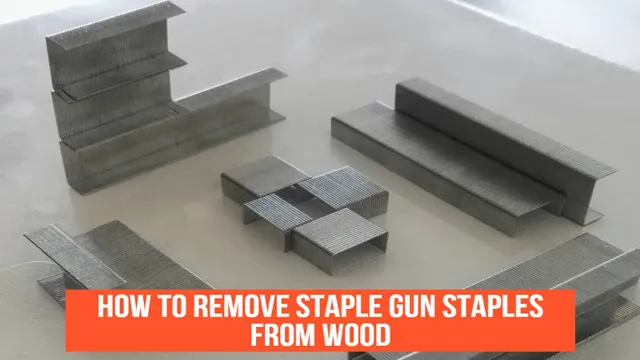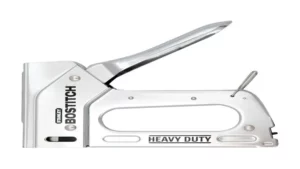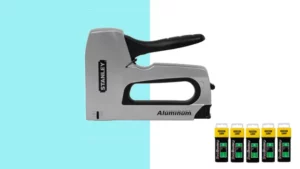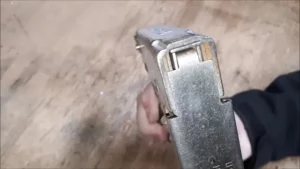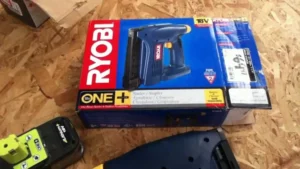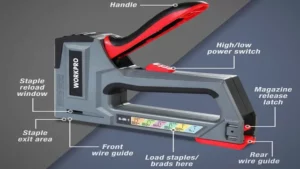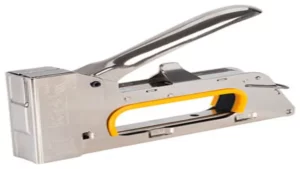Are you planning to remove staple gun staples from your wall but don’t know where to start? Staple gun staples are quite pesky to remove from walls, especially when they have been left there for a long time. But don’t worry, you’re not alone in this! There are various ways to remove staples safely and efficiently, and we’ve got you covered. In this blog post, we’ll give you a step-by-step guide on removing staple gun staples from your walls without damaging them.
So, sit back, grab a cup of coffee, and let’s get started!
Materials Needed
Removing staple gun staples from walls can be a challenging task, but with the right tools and techniques, it can be done with ease. The materials that you’d need for this job are a pair of pliers or needle-nose pliers, a screwdriver, and a putty knife. Once you have these tools handy, you can start the process of pulling out the metal staples from your walls.
First, use the putty knife to gently pry the staples out of the wall by loosening the edges. Then, grip the staple with the pliers and slowly wiggle it out of the wall. If the staple doesn’t come out easily, try leveraging it out with the screwdriver.
With consistent effort, you’ll be able to remove all the staples within a short period, without causing any damage to the wall. It’s essential to ensure that the surface is clean and ready for the following steps, whether it’s painting, renovating, or decorating your walls. So, follow these steps to remove staple gun staples from your wall with minimal hassle!
Staple Remover
If you’re someone who frequently works with documents or papers, chances are you’ve had to remove staples from them at some point. While some people may resort to using their fingernails or other makeshift tools to get the job done, a staple remover can make the task much easier and less frustrating. All you need for this tool is a small metal device with two prongs and a fulcrum.
Simply slide the prongs under the bent part of the staple and push down on the fulcrum to loosen and remove the staple. A staple remover is a quick and efficient way to remove staples without damaging the paper or causing any painful mishaps with your fingers. So, if you find yourself dealing with stapled documents often, investing in a staple remover is definitely worth considering.
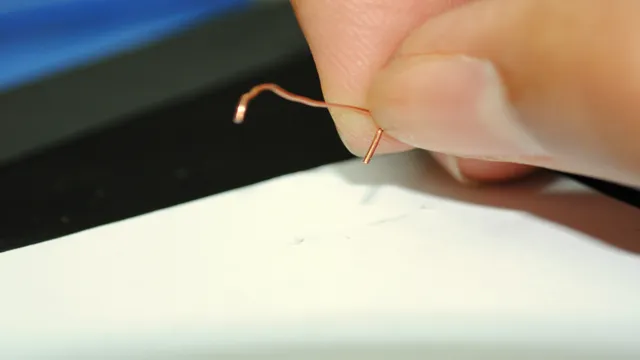
Pliers
When it comes to using pliers, it’s important to have the right materials on hand. Of course, the first thing you’ll need is the pliers themselves, but there are a few other things to consider as well. First, make sure you have a sturdy work surface to work on.
This will provide stability and a comfortable surface to work on. Next, you’ll want to have a variety of different pliers on hand, depending on the task at hand. For example, needle-nose pliers are great for precise work, while slip-joint pliers are better for larger tasks.
Other materials you may need include wire cutters, files, and sandpaper. Don’t forget to wear proper safety gear as well, such as gloves and eye protection. By having all of the necessary materials on hand, you can make your work with pliers not only more efficient but also safer.
Needle-nose pliers
When it comes to DIY projects or repairs, having a good set of needle-nose pliers can be invaluable. These pliers are specially designed to have long, slim jaws that taper to a fine point, allowing for precision gripping and bending of small objects and wires. To get the most out of your needle-nose pliers, you’ll want to make sure you have the right materials on hand.
First and foremost, you’ll need a high-quality pair of pliers that are comfortable to use and made of durable materials like stainless steel. You may also want to invest in some additional tools, like wire cutters or crimping pliers, depending on the specific project you’re working on. In addition, it’s a good idea to have a variety of different-sized jump rings, wire, and beads on hand, so you can easily practice your wire-wrapping and jewelry-making skills.
With the right materials, you’ll be able to tackle a wide range of DIY projects with ease and confidence. So, if you’re looking to expand your DIY toolkit, be sure to add a good pair of needle-nose pliers to your list of essential materials.
Flathead screwdriver
When it comes to DIY projects or simple household repairs, having the right tools is essential. One tool that almost everyone has in their toolkit is a flathead screwdriver. But did you know that not all flathead screwdrivers are created equal? To ensure that you can properly use a flathead screwdriver, you’ll want to make sure that you have the right materials on hand.
First, make sure you have a durable, high-quality flathead screwdriver that fits comfortably in your hand. The last thing you want is a screwdriver that is too big or too small for the job at hand. Next, you’ll want to have the right screws to use with the screwdriver.
Depending on the project, you may need different sizes or types of screws. Be sure to have a variety of screws on hand, so you’re prepared for whatever project comes your way. Finally, make sure you have a sturdy work surface to use when using your flathead screwdriver.
A stable work surface will ensure that you can easily and safely use your screwdriver without damaging the surface or injuring yourself. With these essential materials, you’ll be able to tackle any DIY project or repair with confidence using your trusty flathead screwdriver.
Rubber gloves
Rubber gloves are a common item found in households and workplaces alike. They are a type of protective glove commonly used to prevent contamination or damage to the hands. When selecting rubber gloves, it is important to consider the materials used to ensure they are suitable for the intended purpose.
The materials needed to make rubber gloves typically include natural or synthetic rubber, which provide elasticity and durability to the gloves. Other materials may also be added to improve the gloves’ strength, grip, or resistance to chemicals and heat. Nitrile and latex are commonly used materials for making rubber gloves, with nitrile being a popular choice for those who have allergies to latex.
It is essential to understand the materials used to make rubber gloves to ensure they are suitable for the intended use and to prevent any adverse reactions.
Steps to Remove Staples from Wall
Removing staple gun staples from a wall can be a tedious task, but with the right approach, it can be done quickly and efficiently. The first step is to gather the necessary tools, which include pliers, needle-nose pliers, or a staple remover. Then, carefully pry the staples out of the wall one at a time, using the pliers to grip and pull them out.
Be sure to apply enough pressure to prevent the staple from breaking or leaving a mark on the wall. If the staple is too difficult to remove, try using a needle-nose pliers or a staple remover to grip the staple and pull it out. Once all of the staples have been removed, use a putty knife and spackle to fill any holes left in the wall.
With a little patience and the right tools, you can remove staple gun staples from a wall and restore it to its original state.
Step 1: Evaluate staple size and depth
When removing staples from a wall, the first step is to evaluate the size and depth of the staple. This will help ensure that you use the correct tools and technique for a smooth removal process. Small staples may require a pair of pliers or a staple remover, which can be gently wiggled back and forth to loosen the staple from the wall.
For larger staples, a flathead screwdriver or pry bar may be necessary to loosen the staple before it can be fully removed. It’s important to be cautious when removing staples to avoid damaging the wall or surrounding area. By taking the time to evaluate the staple size and depth before proceeding, you can ensure a successful removal process without any unnecessary damage.
Step 2: Wear rubber gloves for protection
If you’re looking for a quick and efficient way to remove staples from your wall, then you’ll need to take a few key steps to ensure that the job is done safely and correctly. One of the most important things to keep in mind is the importance of wearing rubber gloves during the process. Not only will this protect your hands from any sharp edges or other hazards, but it will also help you maintain a strong grip on the staple remover or pliers that you’re using.
Plus, wearing gloves can also help prevent the spread of any germs or bacteria that might be present on the staples themselves, helping you stay healthy and safe throughout the process. So whether you’re removing staples from a freshly-painted wall or you’re trying to tidy up a messy workspace, be sure to prioritize safety by wearing those protective gloves before you get started.
Step 3: Loosen staple with pliers or screwdriver
Removing staples from a wall can be a frustrating task, but with the right tools and technique, it can be a simple and speedy process. After locating the staples with a metal detector or magnet, the next step is to loosen them using pliers or a screwdriver. It’s important to use a tool that allows you to get a good grip on the staple, making it easier to pry it out of the wall.
A screwdriver or pliers can help to loosen the staple just enough so that you can grab it with your fingers and pull it out completely. It’s essential to be careful not to damage the wall or the area surrounding the staple while attempting to remove it. Once the staple is removed, it’s advisable to clean the area thoroughly and touch up any scuffs or marks left behind.
By following these steps, you can easily remove staples from any wall without any stress or hassle.
Step 4: Use staple remover or needle-nose pliers to pull out staple
Removing staples from walls may seem like a daunting task, but it only takes a few simple steps. After preparing your tools, the first step is to locate the staple and determine if it’s embedded deep into the wall or not. If it’s shallow, using your fingers to pluck it out might do the trick.
However, if it’s deep, use needle-nose pliers or a staple remover to grip the staple as close to the surface as possible. Avoid pulling the staple straight out, as it may damage the drywall surface of your wall. Instead, try wiggling it out slowly while ensuring it comes out in the direction of the staple’s curve.
Keep repeating until the staple pops out entirely. Remember to check for any leftover bits or fragments. Once you’re done, use spackling paste to smooth out the surface and add a fresh coat of paint if necessary.
There you have it, a simple process for removing staples from walls.
Step 5: Repeat process until all staples are removed
Removing staples from walls can be a tedious task, but by following a few simple steps, the process can become much easier. The fifth step is to repeat the process until all staples are removed. This may sound like a daunting task, but as you continue to remove staples, the process will become easier and faster.
Remember to take breaks if you need them and to be careful not to damage the wall or any surrounding areas. By using a staple remover tool and a pair of pliers, you can easily remove staples without using excessive force or causing damage to the wall. By following these steps, you can remove all the staples from your wall quickly and efficiently, leaving you with a clean and smooth surface to work with.
Tips and Precautions
Removing staple gun staples from a wall is not always the easiest task, but with a few simple tips and precautions, you can make the process go more smoothly. First, always wear gloves to protect your hands from any sharp staples and potential injury. Next, use pliers or a staple remover tool to grip the staple firmly and gently rock it back and forth to loosen it from the wall.
Once you have loosened the staple, use your pliers to remove it completely. If a staple is particularly stubborn, you may need to use a flathead screwdriver to pry it from the wall. When removing multiple staples, it can be helpful to use a magnet to collect them and ensure none are left behind.
With these tips, you can safely and easily remove staple gun staples from your walls without damaging the surface or injuring yourself.
Tip 1: Test a small area before removing all staples
When it comes to removing staples from a surface, it’s always a good idea to proceed with caution. One helpful tip is to test a small area before removing all the staples. This ensures that the method you’re using won’t damage the surface beneath the staples.
You can do this by gently prying up a corner of the staple and then pulling it out. If the surface appears undamaged, then you can continue with the larger removal task. Another important precaution is to wear gloves to protect your hands from staple injuries.
Disposing of the removed staples properly is also crucial. You can collect them in a container or wrap them in a thick paper to avoid injuries or damage to other surfaces. By following these simple tips, you can make the staple removal process safe and efficient.
Tip 2: Avoid damaging wall or surface
One of the biggest concerns of DIY home improvement is causing damage to the wall or surface you are working on. Nobody wants to create unnecessary holes or scrapes that require patching or repainting. To avoid this dilemma, there are some easy precautions you can take.
First, be sure to use the right tools for the job. Using a hammer to hang a picture frame may be tempting, but it can cause unwanted damage to your wall. Instead, invest in the proper hanging hardware, such as a picture hook or adhesive strips.
Additionally, take the time to properly measure and align your projects, so you aren’t trying to hastily adjust or take things down. Finally, if you’re unsure about how to proceed, seek advice or help from a professional. A little extra research or assistance can save you time and money in the long run.
By being careful and informed, you can avoid damaging your walls and surfaces during your home improvement adventures.
Tip 3: Dispose of staples properly
Staples are commonly used in offices and homes everywhere, but did you know that disposing of them improperly can be dangerous? When it comes to getting rid of staples, it’s important to be cautious. Many people assume that they can simply toss them in the trash, but the reality is, this can be hazardous. When mixed with other materials, such as paper or plastic, staples can cause harm to the environment, wildlife, and even humans.
Therefore, it’s essential to dispose of staples properly. One solution is to use a staple remover to take the staples off of the paper before disposing of them. In addition, you can also gather them in a container and then take them to a recycling center that accepts metal.
By taking these small steps, you can do your part to protect the planet and avoid any potential dangers associated with careless disposal.
Precaution 1: Wear gloves for protection
When handling any chemicals or potentially harmful substances, it’s essential to protect yourself. One important precaution is wearing gloves. Gloves serve as a barrier between your skin and the chemical, preventing absorption and limiting exposure.
Not all gloves are created equal, so it’s important to choose the right type of glove for the chemical you’re working with. Some types of gloves are resistant to certain chemicals, while others are permeable and may not offer adequate protection. It’s also important to ensure that your gloves fit properly and are in good condition, with no holes or tears.
Always follow safety guidelines and wear gloves when handling chemicals to protect yourself and minimize the risk of harm. So whether you’re a professional chemist or just working on a DIY project, don’t forget to put on those gloves!
Precaution 2: Use caution when using pliers or screwdriver
If you’re doing any kind of DIY and you’ve got a set of pliers or a screwdriver in your hand, it’s important to use caution. While these tools are incredibly useful for a wide variety of tasks, they can also be dangerous if not used properly. One of the most important things to keep in mind when using pliers or a screwdriver is to make sure that you’re wearing the proper protective gear.
This means wearing gloves to protect your hands from cuts or punctures, as well as eye protection to keep debris or shavings from getting into your eyes. Additionally, it’s important to make sure that you’re using the right tool for the job. Using pliers or a screwdriver that’s too small or too large can not only damage the tool or the object you’re working on but also put you at risk for personal injury.
Remember, safety should always come first when working with tools – take the extra precautions so that you can avoid any potential accidents and get the job done right.
Conclusion
Well folks, removing staple gun staples from a wall is a task that can make the most patient person swear like a sailor. But fear not, with a bit of elbow grease and determination, you too can rid your wall of those pesky little buggers. Just remember, safety first! Make sure you wear gloves and protective eyewear to avoid any mishaps.
And if all else fails, you can always find comfort in knowing that you’re not alone in this struggle. So go forth, remove those staples, and triumph over your wall with the satisfaction of a job well done. Happy staple-stripping!”
FAQs
What is a staple gun?
A staple gun is a handheld tool used for inserting staples into various materials such as wood, fabric, plastic, and walls.
How do I remove staple gun staples from a wall?
To remove staple gun staples from a wall, use a flathead screwdriver or pliers to grip the end of the staple firmly and pull it out from the wall. Be careful not to damage the wall or surrounding area.
Can I reuse staple gun staples?
Generally, staple gun staples are designed for single use only and should be replaced after each use. However, some heavy-duty staples can be reused with caution and proper handling.
What are some common uses for a staple gun?
Staple guns are commonly used for home improvement projects such as securing insulation, installing carpet, and framing artwork. They are also used in industries such as construction, roofing, and upholstery.
Can a staple gun staple damage walls?
Yes, if not used properly, a staple gun can cause damage to walls or other surfaces. It is important to use the appropriate size and strength of staple for the job and to carefully aim and place each staple.
How do I choose the right staple gun for my project?
The right staple gun for your project depends on factors such as the materials being used, the strength of the staple needed, and the size of the staples required. Researching different types of staple guns and their features can help you choose the best one for your needs.
Are there safety precautions I should take when using a staple gun?
Yes, always wear appropriate eye and ear protection when using a staple gun. Keep fingers and other body parts clear of the stapling area, and never point the staple gun at yourself or others. Read and follow all manufacturer’s instructions and warnings.
